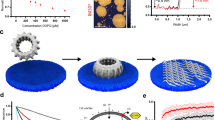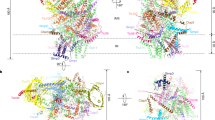Abstract
Membrane proteins impose enormous challenges to cellular protein homeostasis during their post-translational targeting, and they require chaperones to keep them soluble and translocation competent. Here we show that a novel targeting factor in the chloroplast signal recognition particle (cpSRP), cpSRP43, is a highly specific molecular chaperone that efficiently reverses the aggregation of its substrate proteins. In contrast to 'ATPases associated with various cellular activities' (AAA+) chaperones, cpSRP43 uses specific binding interactions with its substrate to mediate its 'disaggregase' activity. This disaggregase capability can allow targeting machineries to more effectively capture their protein substrates and emphasizes a close connection between protein folding and trafficking processes. Moreover, cpSRP43 provides the first example to our knowledge of an ATP-independent disaggregase and shows that efficient reversal of protein aggregation can be attained by specific binding interactions between a chaperone and its substrate.
This is a preview of subscription content, access via your institution
Access options
Subscribe to this journal
Receive 12 print issues and online access
$189.00 per year
only $15.75 per issue
Buy this article
- Purchase on Springer Link
- Instant access to full article PDF
Prices may be subject to local taxes which are calculated during checkout








Similar content being viewed by others
References
Balch, W.E., Morimoto, R.I., Dillin, A. & Kelly, J.F. Adapting proteostasis for disease intervention. Science 319, 916–919 (2008).
Hartl, F.U. & Hayer-Hartl, M. Molecular chaperones in the cytosol: from nascent chain to folded protein. Science 295, 1852–1858 (2002).
Chang, H.-C., Tang, Y.-C., Hayer-Hartl, M. & Hartl, F.U. Snapshot: molecular chaperone, part I. Cell 128, 212–213 (2007).
Tang, Y.-C., Chang, H.-C., Hayer-Hartl, M. & Hartl, F.U. Snapshot: Molecular chaperones, part II. Cell 128, 412–413 (2007).
Doyle, S.M. & Wickner, S. Hsp104 and ClpB: protein disaggregating machines. Trends Biochem. Sci. 34, 40–48 (2009).
Doyle, S.M., Hoskins, J.R. & Wickner, S. Collaboration between the ClpB AAA+ remodeling protein and the DnaK chaperone system. Proc. Natl. Acad. Sci. USA 104, 11138–11144 (2007).
Randall, L.L. & Hardy, S.J.S. SecB, one small chaperone in the complex milieu of the cell. Cell. Mol. Life Sci. 59, 1617–1623 (2002).
Walton, T.A., Sandoval, C.M., Fowler, C.A., Pardi, A. & Sousa, M.C. The cavity-chaperone Skp protects its substrate from aggregation but allows independent folding of substrate domains. Proc. Natl. Acad. Sci. USA 106, 1772–1777 (2009).
Stefanovic, S. & Hegde, R.S. Identification of a targeting factor for posttranslational membrane protein insertion into the ER. Cell 128, 1147–1159 (2007).
Mihara, K. & Omura, T. Cytoplasmic chaperones in precursor targeting to mitochondria: the role of MSF and hsp70. Trends Cell Biol. 6, 104–108 (1996).
Schuenemann, D. Structure and function of the chloroplast signal recognition particle. Curr. Genet. 44, 295–304 (2004).
Schuenemann, D. et al. A novel signal recognition particle targets light-harvesting proteins to the thylakoid membranes. Proc. Natl. Acad. Sci. USA 95, 10312–10316 (1998).
Groves, M.R. et al. Functional characterization of recombinant chloroplast signal recognition particle. J. Biol. Chem. 276, 27778–27786 (2001).
Tu, C.-J., Schuenemann, D. & Hoffman, N.E. Chloroplast FtsY, chloroplast signal recognition particle, and GTP are required to reconstitute the soluble phase of light-harvesting chlorophyll protein transport into thylakoid membranes. J. Biol. Chem. 274, 27219–27224 (1999).
Klimyuk, V.I. et al. A chromodomain protein encoded by the Arabidopsis CAO gene is a plant-specific component of the chloroplast signal recognition particle pathway that is involved in LHCP targeting. Plant Cell 11, 87–99 (1999).
Eichacker, L.A. & Henry, R. Function of a chloroplast SRP in thylakoid protein export. Biochim. Biophys. Acta 1541, 120–134 (2001).
Jonas-Straube, E., Hutin, C., Hoffman, N.E. & Schuenemann, D. Functional analysis of the protein-interacting domains of chloroplast SRP43. J. Biol. Chem. 276, 24654–24660 (2001).
Goforth, R.L. et al. Regulation of the GTPase cycle in post-translational signal recognition particle-based protein targeting involves cpSRP43. J. Biol. Chem. 279, 43077–43084 (2004).
Stengel, K.F. et al. Structural basis for specific substrate recognition by the chloroplast signal recognition particle protein cpSRP43. Science 321, 253–256 (2008).
Hermkes, R., Funke, S., Richter, C., Kuhlmann, J. & Schünemann, D. The α-helix of the second chromodomain of the 43 kDa subunit of the chloroplast signal recognition particle facilitates binding to the 54 kDa subunit. FEBS Lett. 580, 3107–3111 (2006).
Liu, Z. et al. Crystal structure of spinach major light-harvesting complex at 2.72 Å resolution. Nature 428, 287–292 (2004).
Cammarata, K.V. & Schmidt, G.W. In vitro reconstitution of a light-harvesting gene product: deletion mutagenesis and analyses of pigment binding. Biochemistry 31, 2779–2789 (1992).
Paulsen, H., Rumler, U. & Rudiger, W. Reconstitution of pigment-containing complexes from light-harvesting chlorophyll a/b-binding protein overexpressed in Escherichia coli. Planta 181, 204–211 (1990).
DeLille, J. et al. A novel precursor recognition element facilitates posttranslational binding to the signal recognition particle in chloroplasts. Proc. Natl. Acad. Sci. USA 97, 1926–1931 (2000).
Tu, C.J., Peterson, E.C., Henry, R. & Hoffman, N.E. The L18 domain of light-harvesting chlorophyll proteins binds to chloroplast signal recognition particle 43. J. Biol. Chem. 275, 13187–13190 (2000).
Oreb, M., Tews, I. & Schleiff, E. Policing Tic 'n' Toc, the doorway to chloroplasts. Trends Cell Biol. 18, 19–27 (2008).
Li, X., Henry, R., Yuan, J., Cline, K. & Hoffman, N.E. A chloroplast homologue of the signal recognition particle subunit SRP54 is involved in the posttranslational integration of a protein into thylakoid membranes. Proc. Natl. Acad. Sci. USA 92, 3789–3793 (1995).
Jansson, S. A guide to the Lhc genes and their relatives in Arabidopsis. Trends Plant Sci. 4, 236–240 (1999).
Barkow, S.R., Levchenko, I., Baker, T.A. & Sauer, R.T. Polypeptide translocation by the AAA+ ClpXP protease machine. Chem. Biol. 16, 605–612 (2009).
Tomoyasu, T., Mogk, A., Langen, H., Goloubinoff, P. & Bukau, B. Genetic dissection of the roles of chaperones and proteases in protein folding and degradation in the Escherichia coli cytosol. Mol. Microbiol. 40, 397–413 (2001).
Mogk, A. et al. Broad yet high substrate specificity: the challenge of AAA+ proteins. J. Struct. Biol. 146, 90–98 (2004).
Ali, M., Lipfert, J., Seifert, S., Herschlag, D. & Doniach, S. The ligand-free state of the TPP riboswitch: a partially folded RNA structure. J. Mol. Biol. 396, 153–165 (2010).
Sivaraja, V. et al. Three-dimensional solution structures of the chromodomains of cpSRP43. J. Biol. Chem. 280, 41465–41471 (2005).
Goloubinoff, P., Mogk, A., Ben Zvi, A.P., Tomoyasu, T. & Bukau, B. Sequential mechanism of solubilization and refolding of stable protein aggregates by a bichaperone network. Proc. Natl. Acad. Sci. USA 96, 13732–13737 (1999).
Mogk, A. et al. Refolding of substrates bound to small Hsps relies on a disaggregation reaction mediated most efficiently by ClpB/DnaK. J. Biol. Chem. 278, 31033–31042 (2003).
Doyle, S.M. et al. Asymmetric deceleration of ClpB or Hsp104 ATPase activity unleashes protein-remodeling activity. Nat. Struct. Mol. Biol. 14, 114–122 (2007).
Schlothauer, T., Mogk, A., Dougan, D.A., Bukau, B. & Turgay, K. MecA, an adaptor protein necessary for ClpC chaperone activity. Proc. Natl. Acad. Sci. USA 100, 2306–2311 (2003).
Panse, V.G., Vogel, P., Trommer, W.E. & Varadarajan, R. A thermodynamic coupling mechanism for the disaggregation of a model peptide substrate by chaperone SecB. J. Biol. Chem. 275, 18698–18703 (2000).
Hachiya, N. et al. MSF, a novel cytoplasmic chaperone which functions in precursor targeting to mitochondria. EMBO J. 13, 5146–5154 (1994).
Komiya, T., Hachiya, N., Sakaguchi, M., Omura, T. & Mihara, K. Recognition of mitochondria-targeting signals by a cytosolic import stimulation factor, MSF. J. Biol. Chem. 269, 30893–30897 (1994).
Jaru-Ampornpan, P., Chandrasekar, S. & Shan, S. Efficient interaction between two GTPases allows the chloroplast SRP pathway to bypass the requirement for an SRP RNA. Mol. Biol. Cell 18, 2636–2645 (2007).
Yuan, J. et al. ATP stimulates signal recognition particle (SRP)/FtsY-supported protein integration in chloroplasts. J. Biol. Chem. 277, 32400–32404 (2002).
Svergun, D.I. Mathematical methods in small-angle scattering data analysis. J. Appl. Crystallogr. 24, 485–492 (1991).
Svergun, D.I. Determination of the regularization parameter in indirect-transform methods using perceptual criteria. J. Appl. Crystallogr. 25, 495–503 (1992).
Svergun, D.I. Restoring low resolution structure of biological macromolecules from solution scattering using simulated annealing. Biophys. J. 76, 2879–2886 (1999).
Svergun, D.I., Petoukhov, M.V. & Koch, M.H.J. Determination of domain structure of proteins from X-ray solution scattering. Biophys. J. 80, 2946–2953 (2001).
Kozin, M. & Svergun, D.I. Automated matching of high and low resolution structural models. J. Appl. Crystallogr. 34, 33–41 (2001).
Volkov, V. & Svergun, D.I. Uniqueness of ab initio shape determination in small-angle scattering. J. Appl. Crystallogr. 36, 860–864 (2003).
Wriggers, W., Milligan, R.A. & McCammon, J.A. Situs: a package for docking crystal structures into low-resolution maps from electron microscopy. J. Struct. Biol. 125, 185–195 (1999).
Wriggers, W. & Chacon, P. Using Situs for the registration of protein structures with low-resolution bead models from X-ray solution scattering. J. Appl. Crystallogr. 34, 773–776 (2001).
Pettersen, E. et al. UCSF Chimera—a visualization system for exploratory research and analysis. J. Comput. Chem. 25, 1605–1612 (2004).
Acknowledgements
We thank R. Henry (Univ. of Arkansas) for expression plasmids of cpSRP43 and LHCP, C. Robinson (Univ. of Warwick) for plasmids encoding LHCA1 and LHCB5, Z. Liu for help and advice with LHCP reconstitution, A. Sim and V. Chu of the Doniach group and D. Herschlag for help and advice with the SAXS experiments and D.C. Rees, W.M. Clemons, A. Varshavsky, N. Pierce and members of the Shan laboratory for comments on the manuscript. This work was supported by US National Institutes of Health grant GM078024 and career awards from the Burroughs Welcome Foundation, the Henry and Camille Dreyfus foundation, the Beckman foundation and the Packard foundation to S.-o.S. and by US National Institutes of Health program project grant P01-GM-66275 to S.D. and D.H.
Author information
Authors and Affiliations
Contributions
P. J.-A. and S.-o.S. designed experiments; P.J.-A. and T.Z.J. performed the biochemical experiments and analyzed data; V.Q.L. and M.A. performed the SAXS experiment and analyzed data; K.S., M.A. and S.D. carried out molecular dynamics simulations of SAXS data; P. J.-A. and S.-o.S. wrote the paper.
Corresponding author
Ethics declarations
Competing interests
The authors declare no competing financial interests.
Supplementary information
Supplementary Text and Figures
Supplementary Figures 1–7, Supplementary Table 1, Supplementary Note (PDF 3289 kb)
Rights and permissions
About this article
Cite this article
Jaru-Ampornpan, P., Shen, K., Lam, V. et al. ATP-independent reversal of a membrane protein aggregate by a chloroplast SRP subunit. Nat Struct Mol Biol 17, 696–702 (2010). https://doi.org/10.1038/nsmb.1836
Received:
Accepted:
Published:
Issue Date:
DOI: https://doi.org/10.1038/nsmb.1836
This article is cited by
-
Nuclear-import receptors as gatekeepers of pathological phase transitions in ALS/FTD
Molecular Neurodegeneration (2024)
-
Chloroplast SRP43 autonomously protects chlorophyll biosynthesis proteins against heat shock
Nature Plants (2021)
-
Biogenesis of chloroplast outer envelope membrane proteins
Plant Cell Reports (2019)
-
Molecular mechanism of SRP-dependent light-harvesting protein transport to the thylakoid membrane in plants
Photosynthesis Research (2018)
-
Structural basis for cpSRP43 chromodomain selectivity and dynamics in Alb3 insertase interaction
Nature Communications (2015)



